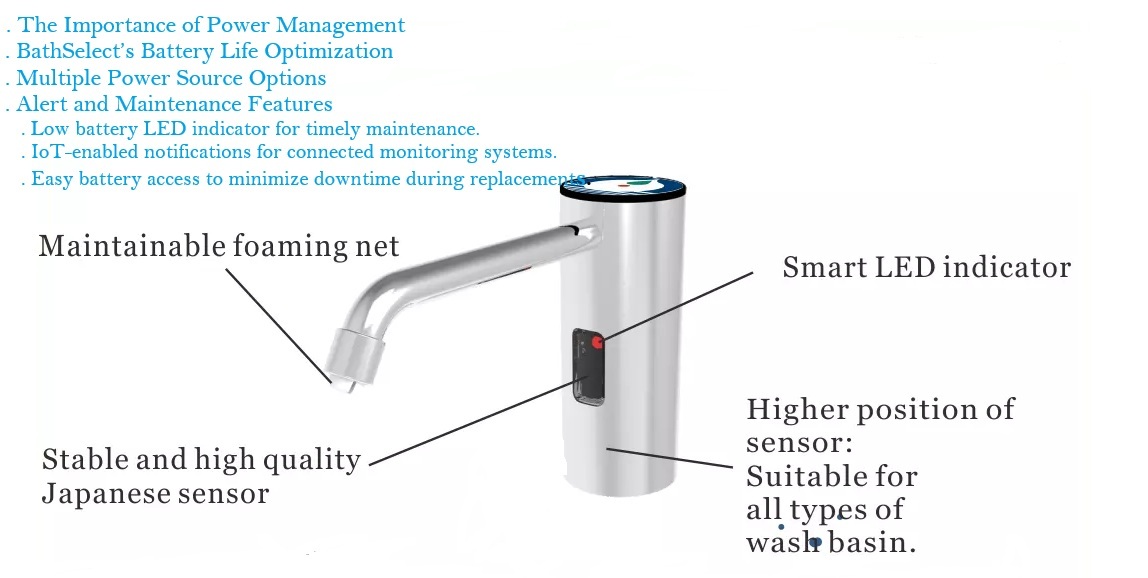Why Specifying Touchless Faucets & Soap Dispensers Is Not Just About Picking Fixtures
1. Regulatory & Legal Compliance
Public restrooms are governed by ADA, UPC/IPC plumbing codes, NSF/ANSI standards, and local water regulations.
A faucet or soap dispenser that looks “good” but isn’t certified could fail inspections, cause costly delays, or trigger liability claims.
Specification ensures all compliance boxes are ticked before construction, avoiding rework.
👉 It’s not just a fixture — it’s a compliance requirement.
2. Health & Hygiene Outcomes
In airports, hospitals, schools, and malls, restrooms are high-touch, high-risk zones for germ transmission.
A properly specified touchless system reduces cross-contamination, improves public health, and increases user confidence.
Poorly specified or cheap fixtures may malfunction, leading users to bypass them — negating hygiene benefits.
👉 It’s not just a fixture — it’s a health safeguard.
3. Sustainability & Environmental Performance
Touchless faucets can save 30–50% water, and foam dispensers reduce soap use by 40%.
These performance levels must be specified in advance — they don’t happen by chance.
Specifications connect product choice with green building goals like LEED/WELL credits.
👉 It’s not just a fixture — it’s a sustainability strategy.
4. Operational Cost & Lifecycle Efficiency
A faucet that fails after 100,000 cycles or a dispenser that clogs monthly costs far more in maintenance, labor, and downtime than a well-specified, spec-grade model.
Multifeed soap systems, dual-power options, and IP-rated batteries lower long-term operational expenses.
Without a clear spec, contractors may substitute lower-grade products that drive up OPEX.
👉 It’s not just a fixture — it’s a cost-control tool.
5. Design & Brand Integration
In hospitality, retail, and corporate projects, restrooms reflect the brand image.
Specifying ensures fixtures match in finish, form, and technology across the project (faucet + dispenser + flush valves).
Inconsistent choices undermine both aesthetics and user perception of quality.
👉 It’s not just a fixture — it’s part of the design language.
6. Professional Authority & Client Trust
Architects and engineers are expected to translate client goals (hygiene, savings, sustainability, aesthetics) into spec-grade solutions.
Simply “picking a product” reduces their role to catalog shopping; specification proves their expertise through performance-driven, documented decisions.
Confidence in specification strengthens the architect–client relationship.
👉 It’s not just a fixture — it’s proof of professional expertise.
📊 Quick Impact Table
Area Risk Without Proper Spec Benefit With Proper Spec
Compliance Inspection failures, liability Smooth approvals, legal protection
Health & Hygiene Germ spread, user distrust Safer, hands-free hygiene
Sustainability Missed LEED/WELL credits Water/soap savings, eco goals met
Cost Efficiency Higher OPEX, frequent repairs Long-term ROI, reduced maintenance
Design Integrity Mismatched finishes, poor UX Cohesive design, brand alignment
Professional Trust Seen as product picker Respected as trusted advisor
✅ Final Takeaway
Specifying touchless faucets and soap dispensers is not just about picking fixtures off a shelf. It’s about ensuring regulatory compliance, protecting health, supporting sustainability goals, optimizing costs, maintaining design cohesion, and demonstrating professional authority. In other words, the specification process transforms simple products into strategic building assets that add long-term value for owners, operators, and users.
